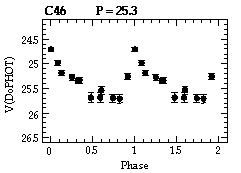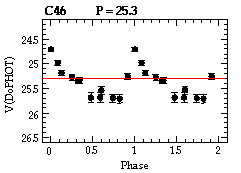



You can calculate the distance to a star if you know its intrinsic brightness, apparent brightness, and the attenuation of light due to any intervening gas and dust.
Recall that a Cepheid is special in that the period of its light variations is proportional to the intrinsic luminosity of the star. Every time you find a Cepheid, you are given its light curve, which is a plot of apparent visual magnitude with ``phase.'' If you not familiar with the magnitude system, and would like to learn about it, you may want to peruse a detailed description of the magnitude system. The apparent magnitude mv is denoted V(DoPHOT) on these light curves from Ferrarese et al. (1996). You might wonder why the data is not plotted as apparent magnitude versus absolute time. Since the brightness variations are periodic, a better sense of the specific variations is achieved by plotting all the points as though they occurred within one cycle. A phase difference of 1 corresponds to one period.
In the light curve of C46 shown above, the phase ranges from 0 to 2. The phase range 1-2 is simply a repeat of phase range 0-1. The full cycle is repeated so the eye can better discern the shape of the light variations.
The average apparent V magnitude for C46 is approximately mv=25.3, as shown below. (The fact that P=25.3 as well is purely coincidence.) Note: the numbers on the vertical axis decrease as you go up the axis.

In Section I, Part B of your lab sheet, write the name of the Cepheid (C46) in column 1. Write the grid number (47) in column 2. Write the average magnitude of the Cepheid (mv=25.3) in column 3. Write the period (P=25.3 days) in column 4.
When you're done, your lab sheet will look like this.
Back to Hunting Cepheids
Back to the table of contents